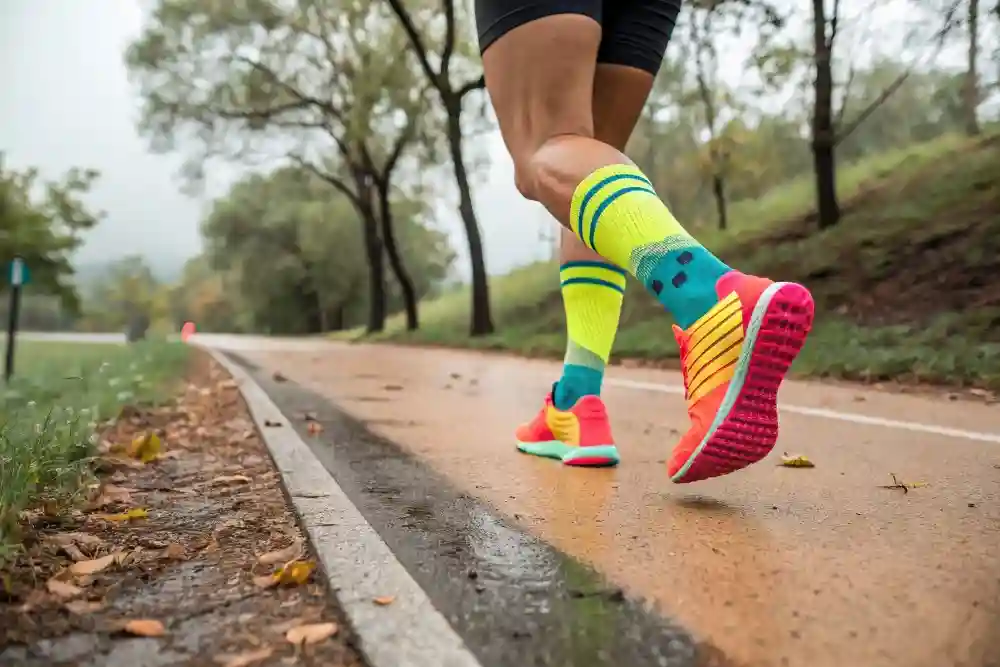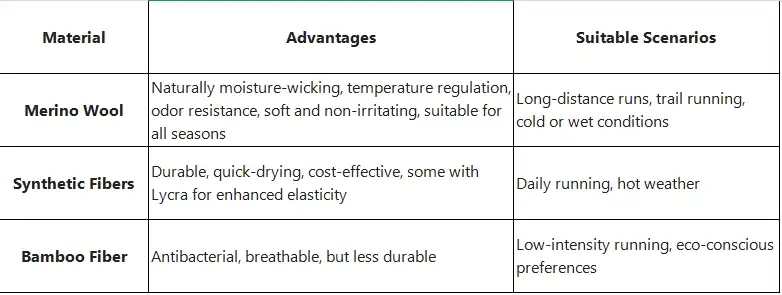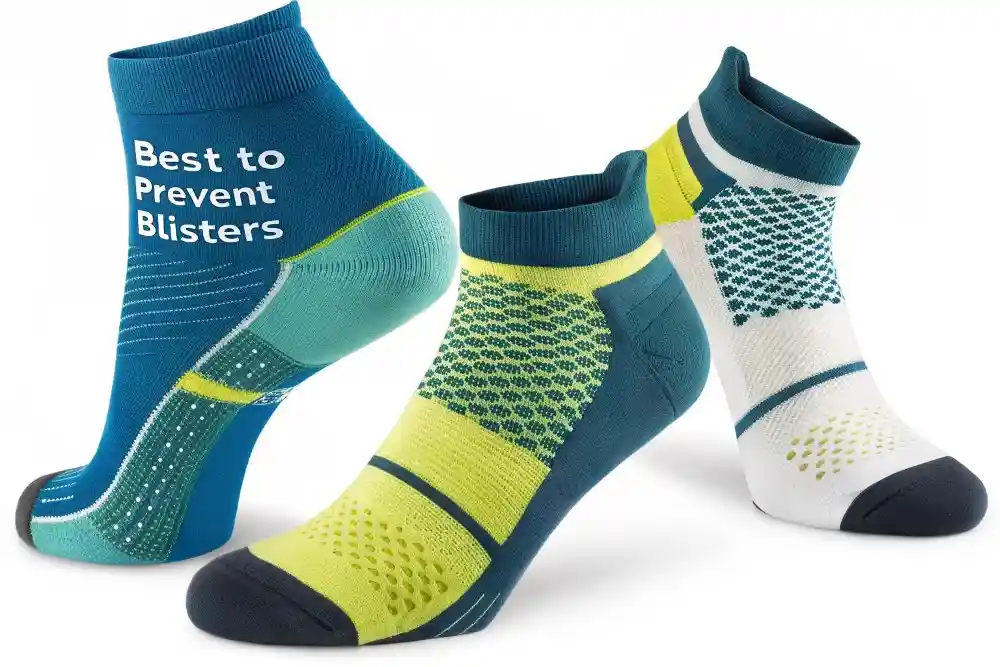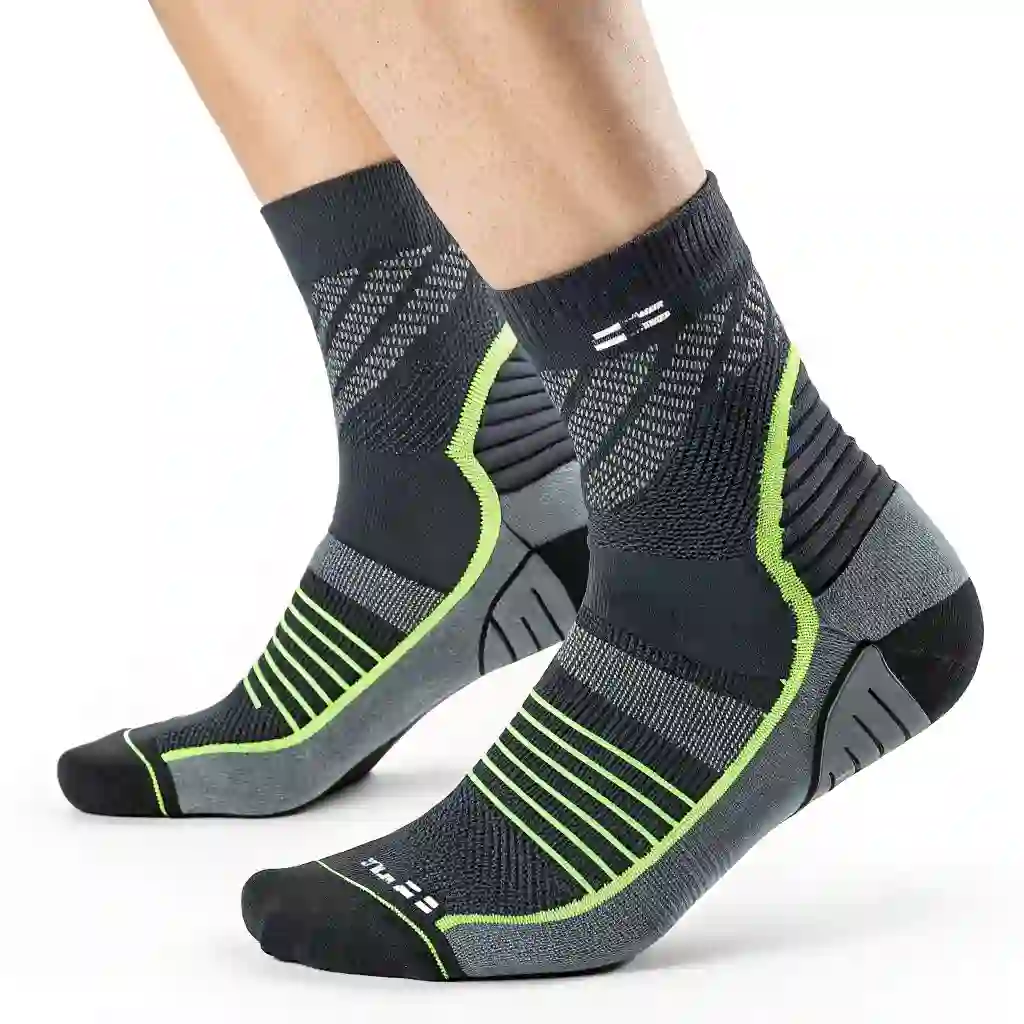Why Running Socks Matter for Retailers
Picture a runner lacing up for their morning jog, only to be stopped in their tracks by painful blisters. It’s a frustration every runner dreads, but custom running socks can turn that pain into a distant memory. With running’s popularity surging, from casual joggers to marathon enthusiasts, the demand for blister-free comfort is booming. For retailers and brands, this isn’t just a trend—it’s a golden opportunity. Offering custom running socks goes beyond selling a product; it’s about solving a universal runner’s problem while building a loyal customer base.
As a leading foreign trade factory, we’re here to help you tap into this lucrative niche. Custom running socks aren’t just footgear; they’re a strategic investment that boosts customer satisfaction, sets your brand apart, and strengthens your market position. In this article, we’ll unpack the magic of running socks—why they matter to your customers, how they elevate your product line, and the customization options that can make your brand unforgettable.

Understanding Blisters: The Problem Behind the Running Socks
Blisters are a common foe for runners, turning an enjoyable activity into a painful ordeal. For retailers and brands, grasping why they occur and how to prevent them is essential to offering products that meet customer needs. This section uncovers the causes of these skin irritations and explains how specialized footwear accessories can keep them at bay.
The Science of Blisters: Friction, Moisture, and Heat
Blisters emerge when the skin faces a combination of friction, moisture, heat, and pressure. Here’s how these elements conspire against your feet:
- Friction: Rubbing between your foot and your shoe or sock separates the skin’s top layer from the one beneath it. This creates a fluid-filled pocket—the hallmark of a blister.
- Moisture: Sweat softens the skin, making it more susceptible to damage. Wet conditions amplify rubbing, increasing the likelihood of irritation.
- Heat: Physical exertion raises foot temperature, triggering more perspiration and worsening the effects of friction.
- Pressure: Shoes that pinch or haven’t been worn in apply uneven force, targeting specific areas and inviting trouble.
Additional culprits include gritty, sweaty feet or tiny intruders like sand or stones in your footwear. These factors heighten discomfort and pave the way for skin issues.
How Running Socks Can Solve These Issues
Specialized socks for runners are crafted to counter these challenges effectively. Here’s how they tackle each problem:
- Dryness: Fabrics like polyester or merino wool pull sweat away from the skin, keeping feet comfortable and less prone to damage compared to cotton, which soaks up liquid.
- Cooling: Certain materials regulate temperature, reducing excessive warmth and sweat during a run.
- Smooth Movement: Features like seamless toes and arch support minimize rubbing by ensuring a secure, irritation-free fit.
- Protection: Padding in key spots—like the heel or forefoot—absorbs impact and eases pressure, shielding vulnerable areas.
These attributes work together to create a barrier against the conditions that harm skin, letting runners focus on their stride.
The Role of Materials and Design in Blister Prevention
The effectiveness of these socks hinges on smart choices in fabrics and construction. Let’s explore why these elements matter:

- Materials: Many runners assume that if their shoes fit well, any socks will do. However, cotton socks often stay damp after absorbing moisture, leading to prolonged friction and eventually blisters. It’s a common mistake that can undo the benefits of even the best running shoes. Synthetic blends or wool varieties excel at keeping feet dry by wicking away perspiration. Merino, for instance, also fights odor naturally, adding an extra layer of freshness.
- Design:
- Seamless construction eliminates rough spots that could chafe, while targeted cushioning protects high-stress zones. A snug fit prevents shifting, ensuring consistent comfort.
- When exploring custom options, don’t overlook sock height. No-show socks work well for road runners looking for minimal coverage, while Crew socks provide extra ankle protection—ideal for off-road trails or colder conditions. A Micro Crew length offers a balanced fit for various climates.
- Consider different cushioning levels when designing or choosing custom socks. Lightweight cushioning appeals to speed-oriented runners who prefer a close-to-foot feel, while medium or maximum cushioning offers extra shock absorption for marathoners or long-distance enthusiasts.
For brands, stocking products with these qualities means delivering real value to customers. It’s about solving a tangible problem—keeping feet safe—so runners can perform at their best. Partnering with a factory versed in custom solutions can help you craft offerings that stand out and address these pain points directly.

Key Features of Running Socks That Prevent Blisters
When it comes to keeping blisters at bay, custom running socks stand out as a runner’s best ally. Designed to fit your feet perfectly, these socks minimize friction and wick away moisture—two major culprits behind blisters. Crafted from materials like merino wool, they excel at keeping your feet dry and comfortable, thanks to their superior moisture-management and smooth texture, while also resisting odor naturally. The precise fit prevents bunching, further reducing irritation during your runs. Pair them with well-fitted shoes tailored to your running style—ideally chosen with a gait analysis from a specialty store—to ensure your feet have room to swell without rubbing.
Advanced Sweat Management
Fabrics engineered to pull moisture away from the skin are critical for maintaining foot hygiene and comfort during prolonged activity. Materials like merino wool or synthetic blends with hydrophilic properties help regulate temperature and reduce bacterial buildup. For brands, sourcing high-performance fibers ensures their products stand out in competitive markets, addressing a core concern for runners: keeping feet dry to minimize irritation. Partnering with a factory that prioritizes innovative fabric technology allows retailers to deliver socks that perform in diverse climates.
Targeted Cushioning
Zonal cushioning in high-stress areas—such as the heel and ball of the foot—absorbs shock without compromising flexibility. This precision engineering reduces strain on joints while maintaining a lightweight feel. Brands can leverage this feature to differentiate their offerings, appealing to athletes seeking injury prevention. Factories with expertise in ergonomic design can tailor padding density to match specific customer demographics, whether for marathon runners or casual joggers.
Friction-Free Design
Traditional seams often create hot spots that lead to discomfort. Seamless knitting techniques, such as circular knitting or flatlock stitching, remove these abrasive points, ensuring a second-skin fit. Retailers targeting performance-driven audiences benefit from promoting this feature, as it directly addresses a common pain point. Manufacturers skilled in seamless construction can offer customizable toe boxes and arch contours, enhancing product appeal.
Graduated Pressure Support
Socks with gradient compression improve circulation, reducing muscle fatigue and accelerating post-run recovery. This technology also stabilizes muscles during activity, enhancing proprioception. For brands, emphasizing these benefits caters to health-conscious consumers seeking multifunctional gear. Collaborating with a factory versed in medical-grade compression standards ensures products meet both athletic and recovery needs, opening doors to cross-market opportunities.
Additional Functional Features
For trail or ultra runners who deal with loose gravel, socks with anti-gravel or anti-slip elements can be a game changer. These features help keep debris out and reduce inward slipping during steep climbs or downhill sprints.
Comprehensive Anti-Blister Strategy
- Waterproof Shoes: To enhance prevention, keep feet dry by swapping socks on long runs or opting for waterproof shoes in damp conditions.
- Materials & Design: Prioritize merino wool or performance synthetics, seamless construction, and arch compression. Add heel anti-slip stickers if possible.
- Fit of Shoes and Socks: Allow for a little extra room to accommodate foot swelling during longer runs, and consider the sock thickness when selecting shoe size.
- Daily Foot Care: Trim your toenails, keep your feet dry whenever possible, and apply friction-reducing creams on high-risk areas such as heels and toes.
- Emergency Treatment: If a blister forms, protect it with blister-specific bandages or sterile dressings to prevent infection and speed up recovery.
Why Customization is the Future of Running Socks
Precision Fit: Addressing Unique Biomechanical Demands
Every athlete’s foot structure and gait pattern differ—high arches, wide heels, or narrow toes require specialized support. Customizable hosiery adapts to these variations, offering contoured arch bands, reinforced zones, or adjustable toe boxes. For brands, providing tailored solutions reduces returns caused by ill-fitting products and builds loyalty among runners who struggle to find off-the-shelf options. Factories with advanced knitting technologies can create size-inclusive designs that cater to niche demographics, from ultramarathoners to weekend warriors.
Distinctive Brand Identity: Standing Out in Crowded Markets
Custom logos, colorways, and patterns transform socks into powerful branding tools. Limited-edition collaborations or seasonal collections allow retailers to tap into trends while fostering emotional connections with consumers. Partnering with a manufacturer capable of small-batch production enables agile responses to market shifts. Highlighting bespoke designs in marketing campaigns elevates perceived value, turning functional gear into collectible apparel that drives repeat purchases.
Versatile Fiber Selection: Balancing Function and Sustainability
From breathable merino wool for temperature regulation to recycled polyester for eco-conscious buyers, material choice defines a product’s appeal. Hybrid blends (e.g., bamboo charcoal-infused yarns for odor resistance or nylon for durability) let brands target specific consumer priorities. Factories offering diverse fiber libraries empower retailers to align with sustainability goals or performance niches, ensuring their catalog meets evolving demands without compromising quality.
Adaptive Aesthetics and Performance: Conquering Every Environment
Geographic and seasonal factors influence sock requirements—mesh panels for tropical climates, thermal layers for winter runs, or reflective accents for low-light safety. Customizable designs let brands cater to regional preferences, whether vibrant patterns for urban athletes or minimalist styles for trail enthusiasts. Manufacturers with expertise in modular knitting can integrate features like moisture-wicking zones or compression gradients, ensuring each pair aligns with both functional needs and visual trends.

Business Benefits of Offering Custom Running Socks
- Meeting Customer Needs: Driving Repeat Purchases
By providing tailored solutions that align with individual preferences, businesses can address specific demands in the athletic wear space. Personalized running socks allow consumers to select features like cushioning, arch support, or moisture-wicking fabrics, fostering a sense of ownership. When clients feel their unique requirements are met, they’re more likely to return for future purchases, transforming one-time buyers into frequent patrons. This ongoing engagement not only boosts revenue but also strengthens relationships, creating a cycle of sustained demand.
- Standing Out in a Saturated Marketplace
In an industry flooded with generic options, differentiation is critical. Customizable products enable brands to carve a distinct identity, appealing to niche audiences seeking specialized performance gear. Limited-edition designs or collaborative collections with athletes can capture attention, positioning the company as innovative and customer-centric. Such strategies help cut through the noise, attracting enthusiasts who value uniqueness over mass-produced alternatives.
- Cultivating Devotion Through Tailored Experiences
Offering high-end, personalized merchandise elevates a brand from a mere supplier to a lifestyle partner. When users invest in products designed exclusively for their preferences, they develop an emotional connection. Superior craftsmanship and attention to detail reinforce perceived value, turning casual shoppers into advocates. Over time, this allegiance translates into word-of-mouth referrals and long-term retention, solidifying the brand’s reputation in a crowded field.
- Enhancing Financial Returns with Unique Creations
Exclusivity drives premium pricing, allowing businesses to command higher margins compared to standard inventory. By introducing bespoke designs or seasonal drops, companies can tap into consumers’ willingness to pay more for items that reflect their individuality. Reduced reliance on discounts and increased perceived worth further amplify profitability, turning specialized offerings into a lucrative revenue stream. This approach not only sustains growth but also future-proofs the brand against market fluctuations.
How to Choose the Right Partner for Custom Running Socks
- What to Prioritize in a Manufacturing Partner: Excellence, Skill, and Trustworthiness
Selecting a hosiery producer requires balancing technical proficiency with collaborative synergy. Beyond assessing product durability and performance, evaluate their familiarity with athletic footwear demands, such as breathability, ergonomic design, and fabric innovation. Reliable partners demonstrate transparency in processes, from prototyping to bulk creation, ensuring consistency across batches. Certifications like ISO or OEKO-TEX® validate adherence to global standards, while investments in advanced machinery signal scalability. Partnering with a vendor that prioritizes clear communication and proactive problem-solving minimizes delays and ensures alignment with your vision.
- Embracing Eco-Conscious and Ethical Manufacturing
Modern consumers increasingly favor brands that align with their values, making sustainability a competitive edge. Seek manufacturers utilizing recycled materials, low-impact dyes, or energy-efficient practices. Ethical labor policies, verified by audits or affiliations with organizations like Fair Wear Foundation, further enhance credibility. Highlighting these commitments in your product storytelling not only attracts eco-aware buyers but also mitigates reputational risks. A partner’s dedication to green initiatives reflects their adaptability to evolving market expectations and regulatory landscapes.
- Collaborate with a Forward-Thinking Manufacturer
As the demand for personalized athletic gear grows, aligning with a factory that combines innovation with scalability ensures your brand stays ahead. From concept to fulfillment, we specialize in turning vision into reality—whether it’s eco-conscious materials, biomechanically optimized fits, or striking visual identities. Let’s redefine what performance hosiery can achieve.
- Why Our Facility Excels in Crafting Your Vision
With decades of expertise in performance hosiery, our operation combines cutting-edge technology with artisan precision. We specialize in small-batch customization, accommodating intricate patterns and functional enhancements like targeted cushioning or moisture control. Our vertically integrated setup—from yarn sourcing to quality assurance—ensures cost efficiency without compromising craftsmanship. Clients benefit from dedicated account managers, expedited sampling (5-day average turnaround), and a 99% on-time fulfillment rate. By prioritizing innovation and ethical production, we empower brands to deliver premium experiences that resonate with discerning athletes.
Conclusion
Custom performance footwear represents more than a product—it’s a strategic tool for brands to deepen customer relationships, amplify differentiation, and elevate profitability. By partnering with technically adept manufacturers, retailers can deliver solutions tailored to athletes’ unique needs, from blister-resistant designs to climate-adaptive fabrics.
Start designing your bespoke line today to meet rising demand for individuality, quality, and purpose-driven performance.
FAQs
Why choose custom running socks over standard designs?
Custom running socks address specific athletic needs, such as blister prevention, arch support, and climate adaptability. They also allow personalization (e.g., colors, patterns, or monograms), creating a unique product that resonates with runners’ identities and performance goals.
How do I design custom running socks for trail vs. road runners?
Tailor features to activity demands:
- Trail runners: Prioritize reinforced toe/heel zones and rugged, moisture-wicking fabrics.
- Road runners: Focus on lightweight breathability and seamless stitching to reduce friction during high-mileage runs.
Partner with manufacturers to refine materials and ergonomic fits for each use case.
Can I integrate advanced technologies like compression zones into custom designs?
Absolutely! Embed targeted compression (e.g., calf support), anti-odor treatments, or thermoregulating fabrics. These innovations appeal to performance-focused runners seeking a competitive edge.
Are there eco-friendly packaging options for custom orders?
Yes! Opt for recycled cardboard boxes, biodegradable poly mailers, or seed paper tags that customers can plant. Emphasize sustainability in your branding to attract eco-conscious runners and align with global zero-waste trends.
Can I add reflective elements for nighttime runners?
Integrate reflective strips or reflective yarn into designs. Promote these as safety-forward features for urban runners and host “Visibility Challenges” to showcase their effectiveness in low-light conditions.
Are there material innovations for runners with allergies or sensitive skin?
Opt for hypoallergenic fibers like organic cotton, bamboo charcoal, or OEKO-TEX® certified synthetics. Collaborate with manufacturers to exclude latex or harsh dyes, and market these options as “Mother and Baby” for sensitive skin.
